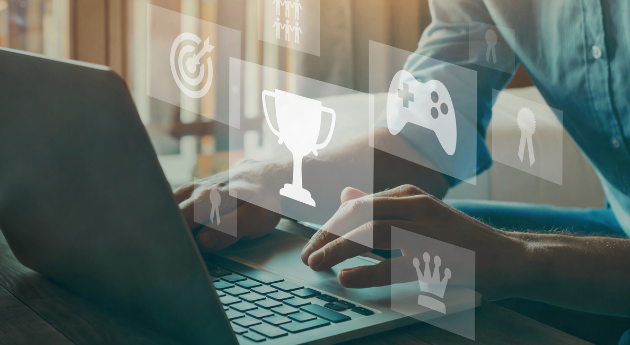
Gamification: The Bridge Between Learner Motivation and Competitive Behavior
Did you know that adding gamification has shown a 60% increase in employee engagement, according to a recent report? This statistic is not surprising given the fact that gamification has become one of the most talked-about topics amongst learning and development (L&D) professionals over the last few years. In fact, one of the most significant benefits of implementing a gamification strategy in training programs is helping enhance learner retention by keeping them engaged, motivated, and satisfied. Gamification can also contribute to promoting healthy workplace competition.
With these benefits in mind, here’s everything you need to know about the motivational factors to enhance learning, how to promote healthy workplace competition, and how gamification bridges these two factors.
Two Motivations At the Workplace
Motivation plays a critical role in employee performance, and motivated employees tend to have higher productivity levels, subsequently translating into business growth. At the workplace, motivation can be of two types: intrinsic and extrinsic. Intrinsically motivated members are powered by themselves and are not driven by material goals to accomplish a task. Intrinsic motivation is when completing a task provides a sense of satisfaction and feels personally rewarding. On the other hand, extrinsic motivation involves the drive to complete a task based on external rewards such as bonuses, appraisals, promotions, etc. Given these vastly different motivational factors, L&D heads need to keep both in mind when designing their gamification strategies.
Combining Motivation with Competitive Behavior
Gamification helps spark healthy competition, camaraderie, and collaboration among team members. Core gaming characteristics such as competitive behavior, challenges, reward systems, and instant feedback can boost learners’ motivation and engagement and uplift their mood. Moreover, gamification brings out the innate human tendency of striving to better themselves. Motivation and competitive behavior can pave the way for self-improvement and continuous learning – a must-have in today’s business world.
Further, maintaining a positive employee experience has also become crucial to business success, with employees still adjusting to new hybrid working models. In such a highly competitive landscape, retaining and acquiring top-notch talent has become essential. Upskilling and reskilling have gained prominence as employers seek innovative ways to retain their employees, and gamification can have a tremendous competitive advantage when attracting and retaining top talent, especially in times of the Great Resignation. Thus, a company that doesn’t look at its talent as a competitive advantage could be poised to lose its standing in the industry.
How Does Gamification Work
The goal of gamification is to improve learner retention, course completion rates, and employee engagement – and at the same also contribute to the professional goals of employees. An effective gamification strategy encompasses both motivational factors and can be formed upon three main factors: gaming mechanics, learner emotions, and behavior. Gaming mechanics specify the learner’s competencies and goals to earn rewards such as badges, tokens, and certificates. The learner’s emotional state involves positive and negative emotional reactions, such as excitement and disappointment. The consequent actions such as taking tests, quizzes, or sharing acquired knowledge accounts for the learner’s behavior. Thus, the purpose of gamification is not just to make learning fun but also to make the learning of everyday tasks more engaging and exciting. Gamification empowers learners to manage their learning outcomes, promotes knowledge sharing among team members, enables shorter feedback cycles, and drives behavioral change through superior employee engagement.
With automation becoming mainstream, humans will need to make the shift from performing mundane and repetitive tasks to more skill-based and intelligent projects. In this regard, it is increasingly apparent that L&D is using the power of AI, Augmented Reality, and Virtual Reality to make gamification more interesting.
Gamification can also help employees build on their skill sets to excel in specific work areas. Internally, building a gamification competency has become critical in upgrading a business to the next level through employee growth.
Levels, Battles, Badges, and Leaderboards to Build More Skin in the Game
The key features of gamification for training programs involve reaching a goal, acquiring a defined skill set, rewards, interacting with other users, and indulging in competitive behavior. Badges, leaderboards, and scorecards can help track a learner’s achievements, promote positive reinforcement, and nurture healthy workplace competition. The levels are helpful to keep learners engaged with new content and increase difficulty at every level. They also help employers monitor learning progress, make changes in the program as and when required, and manage employee skill sets.
Other gamification features such as inter-team or player-vs-player quizzes with real-time feedback – combined with social learning features such as activity feeds and in-game chats – help create an informal learning experience within a formal working environment. Gaming mechanics also help bridge the gap between high-performing and low-performing learners. An example of this is experience points and streaks, which are awarded as learners progress through their learning journeys while demonstrating the learners’ familiarity with their learning environment. At the same time, streaks may record answering questions or attending a course for days in a row, further supporting the reward program. This helps keep employees engaged and motivated by maintaining their streaks with peers.
Recent market trends indicate how L&D is undergoing a seismic shift; upskilling and reskilling initiatives have become top priorities. Businesses are keen to leverage technologies like gamification to innovate and build a skilled workforce based on employee competencies. The need of the hour is to create an effective training strategy that identifies existing challenges within the training setup, understands learners’ aspirations, and implements an appropriate gamification solution.
To learn more about gamification and how we can help you implement it within your business, talk to our experts today.
